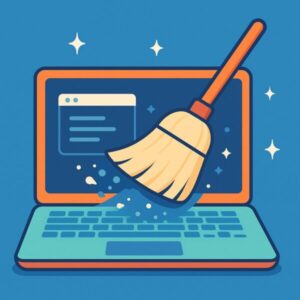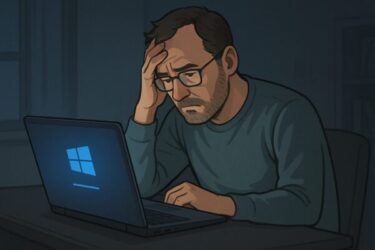
“Is your PC feeling sluggish lately?”
“Startup takes forever, and even opening a browser is painfully slow.”
If this sounds familiar, you’re definitely not alone. Many Windows users notice their PC slowly getting worse over time—even if they’re not installing anything “heavy.”
The good news: slow performance doesn’t always mean your PC is dying. In most cases, it’s just cluttered on the inside.
In this article, we’ll walk through step-by-step methods to clean and optimize your Windows PC—even if you’re not tech-savvy.
Common Symptoms of a Cluttered PC
- Startup takes more than a minute to reach the desktop
- Switching between folders and apps feels delayed or jerky
- Web pages load slowly in any browser
- Videos stutter or lag while playing
- Installing or uninstalling apps takes unusually long
These issues are often caused by unseen clutter inside your system—temporary files, app cache, too many background processes, and more.
Why Does Windows Get Slower Over Time?
| Cause | Explanation |
|---|---|
| Temporary Files & Cache | Automatically generated files pile up and take up precious disk space. |
| Background Apps | Hidden apps running in the background keep using memory and CPU. |
| Startup Programs | Too many auto-start apps slow down the boot process and first few minutes after login. |
| Registry Errors | Old or corrupted registry entries can cause delays or odd glitches. |
| Software Fragments | Leftover junk from old updates or uninstalled apps builds up over time. |
Let’s look at how you can clean up your PC manually—step by step.
Easy Fixes You Can Try Right Now
1. Use Task Manager to Disable Startup Apps
- Press
Ctrl + Shift + Escto open Task Manager. - Go to the “Startup” tab.
- Right-click unnecessary apps and choose “Disable.”
- Restart your PC and see if startup feels faster.
2. Delete Unnecessary Files and Cache
- Open Settings → System → Storage.
- Click on “Temporary Files” and delete unneeded items.
- Clear browser cache/history from Chrome or Edge (especially if you never clear it).
3. Clean Up Your Browser
- Clear cookies and cached files.
- Remove unused or suspicious extensions.
- If the browser still feels slow, try restarting it—or temporarily use another browser.
4. Adjust Graphics and Power Settings
- If your PC is very old or low-spec, try lowering the resolution slightly (for example, from 1920×1080 to 1600×900).
- Go to Settings → System → Power & battery (or Power & Sleep → Additional power settings on some builds).
- Select a “Balanced” or “High performance” plan instead of power-saving mode.
5. Run Disk Cleanup & System Scans
- Search for
Disk Cleanupfrom the Start menu and run it on your system drive (usually C:). - Open Command Prompt as Administrator and run:
sfc /scannow - Check for updates via Settings → Windows Update to ensure you have the latest fixes.
Too Complicated? Try a One-Click Tool
Not sure which files are safe to delete? Worried about accidentally removing something important?
In that case, an all-in-one cleanup tool can help automate the process for you 👇
[Sponsored Link] One-Click Optimization: Avast Cleanup Premium
Speed up your PC safely with Avast Cleanup Premium (1-Year Online Code). It helps clean junk files, tidy up the registry, and optimize performance in just a few clicks.
Real-Life Example
On a 5-year-old laptop that took over 2 minutes to boot, using a cleanup and optimization tool brought noticeable improvements:
- 🕒 Boot time reduced from about 2 minutes to under 1 minute
- 🌐 Smoother browser scrolling and tab switching
- 💻 Apps opened more quickly and felt more responsive overall
Results vary by PC, but even older devices can often feel “lighter” after a proper cleanup.
FAQ
Q1: Are free cleanup tools enough?
A: Free tools can handle basic cleanup, but many of them don’t offer deeper optimization, automation, or scheduling. A paid tool can be more convenient if you want ongoing, hands-off maintenance.
Q2: Does it work with Windows 11?
A: Yes, Avast Cleanup Premium supports Windows 11, including recent versions such as 24H2, according to the official product information.
Q3: Is it safe to use?
A: Avast is a long-standing cybersecurity vendor, and many users and companies rely on its products. As with any system tool, review the settings before cleaning and make sure you understand what will be removed.
Final Thoughts: Don’t Give Up on Your PC Yet
A slow PC doesn’t always mean it’s time to buy a new one.
Start with simple cleanup: remove unnecessary startup apps, clear temporary files, and run basic maintenance. You may be surprised how much faster your system feels afterward.
If you prefer an easier route, tools like Avast Cleanup Premium offer a straightforward, guided way to tidy up your PC with fewer manual steps.
Taking a little time now to clean and optimize your system can help you avoid freezes, crashes, and frustration later.
✔️You might also find these helpful:
▶︎Windows Won’t Boot After July 2025 Update? Fix Black Screen & Startup Loops
▶︎How to Fix Display Issues After Windows Update (2025 Guide)
💡 Looking for more tips? Check out our full list of Windows Help Guides.


